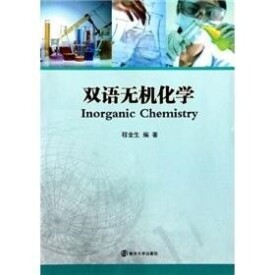雙語無機化學
雙語無機化學
Chapteration version
作 者:程金生 著
叢 書 名:出 版 社:南京大學出版社編輯:吳華 ISBN:9787305069772 出版時間:2010-06-01 版次:1頁 數:263 裝幀:平裝 開本:16開 所屬分類:圖書 > 科學與自然 > 化學
《雙語無機化學》根據國內外無機化學領域的發展趨勢,依據“基礎性與新穎性”並存的原則,歷時數載編撰而成。全書共分十二章節,圖文並茂,從原子結構出發,以元素周期表為主線,涵蓋了化學熱力學、化學動力學、原子結構、化學鍵與分子結構、化學平衡原理、氧化還原反應、元素化學(包括主族元素和過渡元素)、鑭系及錒系元素、無機化學新興領域等諸多知識點,各章節有一定的獨立性,聯結起來又成一體。全書語言平實,內容精練,力求將無機化學學科最精華的部分展現給讀者,同時注重知識點的“新”和“精”,強調前沿與基礎相結合,突出基礎理論和實際應用相銜接。
《雙語無機化學》可供化學、藥學、材料、物理、化工、冶金及醫學檢驗等學科相關技術人員專業參考,亦適合普通高等學校理工、化學、藥學、醫學檢驗等相關專業無機化學雙語教學使用,同時也可作為化學、藥學等相關專業碩士研究生的專業參考用書。
目錄:
Introduction
0.1 Chemistry: A Science for the 21st Century
0.2 Scientific Method of Inorganic Chemistry
0.3 The Relationship of Inorganic Chemistry and Other Subjects
0.4 How do You Study This Course to Get Well?
Exercises
Chapter 1 The Behaviors of Gas, Liquid and Solution
內容提要
1. 1 The Properties of Gases
1.2 The Properties of Liquid
1.3 The Properties of Solutions
Exercises
Chapter 2 Chemical Thermodynamics
內容提要
2.1 First Law of Thermodynamics
2.2 Second Law of Thermodynamics
2.3 Third Law of Thermodynamics
2.4 Gibbs Free Energy
2.5 Hess's Law
Exercises
Chapter 3 Chemical Dynamics
內容提要
3. 1 The Rates of Chemical Reactions
3.2 Transition State (Eyring, 1930's)
3.3 Catalysis
Exercises
Chapter 4 The lonization Equilibria and Theories of Acids & Bases ..
內容提要
4.1 Theories of Acids and Bases
4.2 Strong and Weak Bases
4.3 Strong and Weak Acids
4.4 Common Ion Effect and Buffered Solution
4.5 The Dissociation of Weak Polyacids and Hydrolysis of Salts
Exercises
Chapter 5 The Equilibrium of Precipitation and Dissolution
內容提要內容提要
5.1 Solubility Product
5.2 QSP, Ks, and Saturation
5.3 Molar Solubilities and Solubility Products
5.4 The Common-Ion Effect
5.5 How to Separate Ions by Selective Precipitation
5.6 The Simultaneous Equilibria Between Precipitations
Exercises
Chapter 6 Oxidation-Reduction Reactions & Electrochemistry
內容提要內
6.1 Oxidation-Reduction Reactions
6.2 Electrode Potential
6.3 Electrochemical Cells
6.4 The Nernst Equation
6.5 Some Application
Exercises
Chapter 7 The Atomic Structure and the Periodic Properties of the Elements
內容提要
7.1 Atom Structure
7.2 The Spectrum of Atomic Hydrogen and Bohr's Theory
7.3 Atomic Orbitals and Electron Configurations
7.4 The Periodic Properties of the Elements
Exercises
Chapter 8 Chemical Bonds and Structures
內容提要
8.1 Covalent Bonds
8.2 Molecular Geometry
8.3 Ionic Bond
8.4 The Structures of Crystalline Solids
8.5 Metallic Bond
8.6 Intermolecular Bonding- Van der Waals Forces
8.7 Intermolecular Bonding Hydrogen Bond
Exercises
Chapter 9 The Main-Group Elements
內容提要
9.1 Introduction
9.2 The Chemistry of Hydrogen
9.3 The Alkali Metals (Group 1 or Group IA)
9.4 The Alkaline Earth Metals (Group 2)
9.5 Boron Group (Group 13)
9.6 Carbon Group (Group 14)
9, 7 Nitrogen Group (Group 15)
9.8 Chalcogen Group (Group 16)
9.9 Halogens Group (Group 17)
9.10 The Noble Gases (Group 18)
Exercises
Chapter 10 The Transition Metal Elements
內容提要
10.1 Introduction
10.2 Group 4 (The Titanium subgroup)
10.3 Group 5 (The Vanadium Subgroup)
10.4 Group 6 (The Chromium Subgroup)
10.5 Group 7 (The Manganese Subgroup)
10.6 Group 8 (The Iron Subgroup)
10.7 Group 9 (The Cobalt Subgroup)
10.8 Group 10 (The Zinc Subgroup)
10.9 Group 11 (The Copper Subgroup)
Exercises
Chapter 11 The Lanthanides and Actinides
內容提要
11.1 Definitions
11.2 Periodicity
11.3 Lanthanides
11.4 Actinides
11.5 Uranium Chemistry and Nuclear Chemistry
Exercises
Chapter 12 Introduction of Bio-lnorganic Chemistry ..
內容提要
12.1 Introduction
12.2 Major Areas of Bio-Inorganic Chemistry
12.3 Biomedicine Application
Exercises
Appendix A. References and Further Reading
Appendix B: International System of Units (SI) and Units Conversion
Appendix C: Saturation Vapor Pressure over Water for Different Temperatures
Appendix D: Dissociation Constant K for Weak Acid and Weak Base
Appendix E: Other physical properties for Some Typical Compounds
Appendix F: Solubility-Product Constants (Ksp) of Slightly Soluble Ionic Compounds at 298 K
Appendix G: Standard Electrode Potentials in Aqueous Solution
Appendix H. Standard Heat of Combustion for Typical Organic Compounds
Appendix I: Periodic Table of Elements
